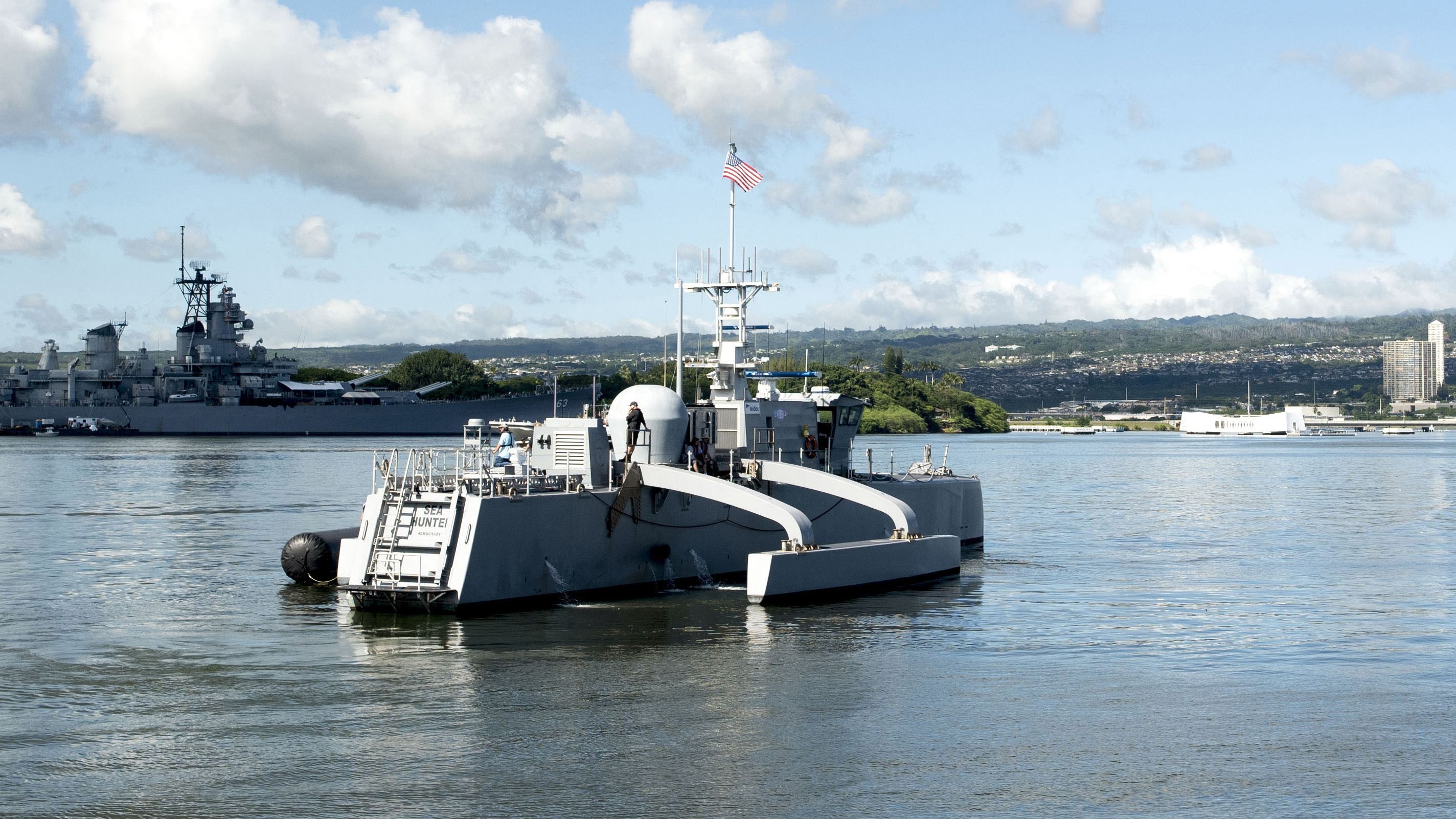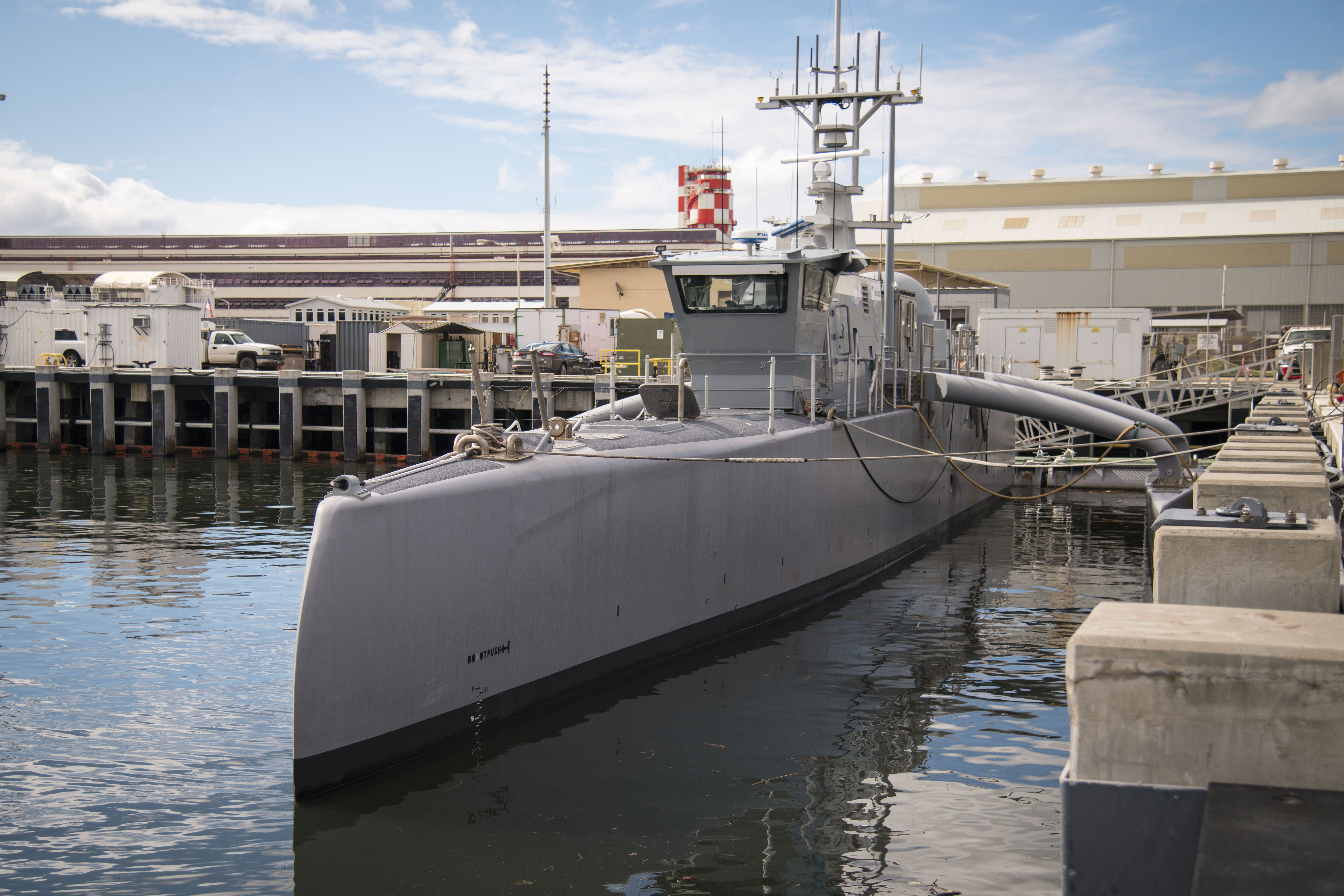
THE PENTAGON – The Navy released a draft request for proposals for its Medium Unmanned Surface Vehicle as the Office of Naval Research continues to prove out the autonomous control system on a first test ship.
The MUSV program – whose role in future fleet operations continues to grow as the Navy looks to become more distributed and more reliant on unmanned ships and planes to supplement manned ones – began as a DARPA research initiative and moved to ONR in January 2018.
Robert Brizzolara, the MUSV program manager, told USNI News on April 25 at the Defense Department’s annual Lab Day at the Pentagon that ONR has been focused on building an extensive body of evidence to prove to the fleet the reliability of the MUSV hull and the autonomous control system that lets it sense its way through the seas.
Brizzolara said the 132-foot hull has good range and endurance, good sea keeping and an impressive payload capacity due to its size. With no crew requiring berthing, plumbing and other needs, the ship can save on space and weight – and therefore cost.
“The combination of no people onboard and lower cost means that a commanding officer, when it becomes an operational asset, could put it in much more hazardous areas and he or she could take more risks with it,” he said.
“And if they had enough of them, they could be willing to lose some, and they wouldn’t care because they’re cheap and there’s no people on them. So that’s the benefit.”
But commanding officers wouldn’t choose to rely on the MUSV until evidence shows it can stay ready for tasking, so that’s what Brizzolara and his team are continuing to work on until the program transitions to Naval Sea Systems Command in Fiscal Year 2020.

Last fall, the Sea Hunter MUSV traveled from San Diego to Pear Harbor, Hawaii, on its own with no intervention from a navigational standpoint. On the voyage out, a crew following nearby on an escort ship boarded Sea Hunter three times to fix mechanical problems. In one instance, one of two engines shut down, and two problems occurred with one of two generators. Brizzolara said the team could have let Sea Hunter keep going on a single engine or single generator, but they chose to make temporary repairs at sea out of an abundance of caution to avoid the unmanned ship ended up dead in the water.
“With a manned ship, if something breaks, the commanding officer will send somebody down to fix it. with this, we don’t have that. So on the way to Hawaii, actually a couple things did break in terms of mechanical systems, so we had to board Sea Hunter and fix them and then send it on its way,” he said, noting this actually helps prove out the contingency plan for repairs at sea.
“Coming back from Pearl Harbor to San Diego, it did 10 days with no people onboard, no problems, no boardings necessary, so that was a success,” he said.
“So we showed that 10-day mission duration with no people onboard, which is a significant milestone.”

ONR currently has just one Sea Hunter vehicle to use in testing. A second vessel is being built by Leidos and should be in the water by late FY 2020, but Brizzolara said it was unclear if that vessel would go to ONR or straight to NAVSEA.
Even as ONR continues to prove the reliability of Sea Hunter and its autonomy system, NAVSEA released a draft request for proposals for the MUSV program last week, after hosting an industry day in February to discuss notional plans and the state of current technology. NAVSEA will likely award a contract for the program before October.
The Navy intends for the MUSV to sustain speeds of 24 to 27 knots, operate in sea states 4 or 5, while surviving up to sea state 7; and spend 60 to 90 days at sea without returning to port, according to Navy slides reviewed by USNI News.

The Navy has made clear it expects unmanned ships, aircraft and underwater vehicles to play a major role in future operations, and the service is devoting significant funds to developing and fielding these vehicles as fast as research and industry can manage. The medium USV is envisioned to be primarily a sensing platform for the fleet, while a large USV the Navy is now aggressively pursuing would be a remote shooter.
Brizzolara said it would be up to NAVSEA and others in the Navy to determine what payloads to integrate onto MUSV, but he said he believes that designing MUSV as a multimission truck will prove useful to fleet commanders.
“Our focus (at ONR) is on the testing of the platform and the autonomy. Sometime during Fiscal Year 20, the platform is going to transfer over to NAVSEA, and that’s where the serious work is going to start in terms of looking at concepts of employment and what missions and what mission systems or payloads will go on here,” he said.
“In my opinion, speaking generally, this type of platform would be useful for intelligence, surveillance and reconnaissance (ISR), mine countermeasures and anti-submarine warfare. And those are three very broad areas, so there’s a number of places in there where this could contribute a lot towards those missions.”
The aft deck of Sea Hunter has quite a bit of space for a payload and is particularly well suited for ISR missions, he said.
“The commanding officer could, if he had a few of these, could position these way out in front of the battle group, and they’d be the scouts or the pickets. And they’d also take the first fire, and if they lost a couple, who cares,” Brizzolara said.





